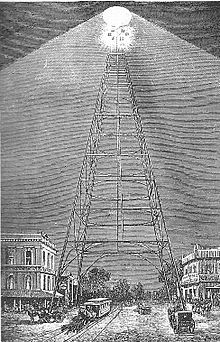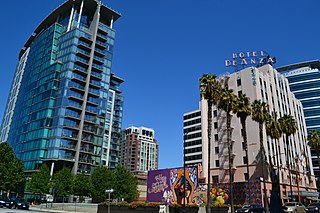
San Jose, officially San José, is a major city in the U.S. state of California that is the cultural, financial, and political center of Silicon Valley and largest city in Northern California by both population and area. With a 2020 population of 1,013,240, it is the most populous city in both the San Francisco Bay Area and the San Jose-San Francisco-Oakland Combined Statistical Area, which contain 7.7 million and 9.7 million people respectively, the third-most populous city in California, and the tenth-most populous in the United States. Located in the center of the Santa Clara Valley on the southern shore of San Francisco Bay, San Jose covers an area of 179.97 sq mi (466.1 km2). San Jose is the county seat of Santa Clara County and the main component of the San Jose–Sunnyvale–Santa Clara Metropolitan Statistical Area, with an estimated population of around two million residents in 2018.

An arc lamp or arc light is a lamp that produces light by an electric arc.

The Santa Clara Valley is a geologic trough in Northern California that extends 90 miles (145 km) south–southeast from San Francisco to Hollister. The longitudinal valley is bordered on the west by the Santa Cruz Mountains and on the east by the Diablo Range; the two coastal ranges meet south of Hollister. The San Francisco Bay borders the valley to the north, and fills much of the northern third of the valley. The valley floor is an alluvial plain that formed in the graben between the San Andreas Fault to the west and the Hayward and Calaveras faults to the east. Within the valley and surrounding the bay on three sides are the urban communities of San Mateo County, Santa Clara County, and Alameda County, while the narrow southern reaches of the valley extend into rural San Benito County to Hollister. In practical terms, the central portion of the Santa Clara Valley is often considered by itself, contained entirely within Santa Clara County.
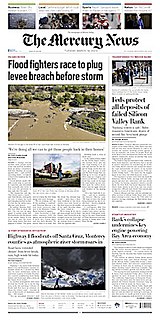
The Mercury News is a morning daily newspaper published in San Jose, California, in the San Francisco Bay Area. It is published by the Bay Area News Group, a subsidiary of Digital First Media. As of March 2013, it was the fifth largest daily newspaper in the United States, with a daily circulation of 611,194. As of 2018, the paper has a circulation of 324,500 daily and 415,200 on Sundays. As of 2021, this further declined. The Bay Area News Group no longer reports its circulation, but rather "readership". For 2021, they reported a "readership" of 312,700 adults daily.

The history of street lighting in the United States is closely linked to the urbanization of America. Artificial illumination has stimulated commercial activity at night, and has been tied to the country's economic development, including major innovations in transportation, particularly the growth in automobile use. In the two and a half centuries before LED lighting emerged as the new "gold standard", cities and towns across America relied on oil, coal gas, carbon arc, incandescent, and high-intensity gas discharge lamps for street lighting.
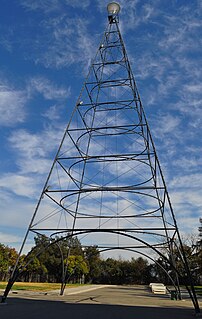
History Park at Kelley Park in San Jose, California, USA is designed as an indoor/outdoor museum, arranged to appear as a small US town might have in the early 1900s (decade). Since its inauguration in 1971, 32 historic buildings and other landmarks have either been moved from their original San Jose locations or are represented by replicas.
A moonlight tower or moontower is a lighting structure designed to illuminate areas of a town or city at night.

Charles Francis Brush was an American engineer, inventor, entrepreneur, and philanthropist.
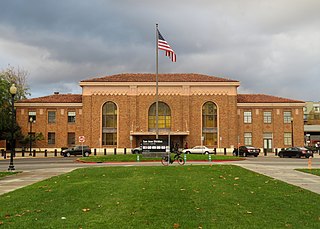
San Jose Diridon station is the central passenger rail depot for San Jose, California. It also serves as a major intermodal transit center for Santa Clara County and Silicon Valley. The station is named after former Santa Clara County Supervisor Rod Diridon.
Silicon Valley Power (SVP) is a not-for-profit municipal electric utility owned and operated by the City of Santa Clara, California, USA. SVP provides electricity service to approximately 55,116 residential and business customers, including large corporations such as Intel, Applied Materials, Owens Corning and NVIDIA. SVP also owns and maintains a dark fiber network named SVP Fiber Enterprise.

San Jose, California, is the third largest city in the state, and the largest of all cities in the San Francisco Bay Area and Northern California, with a population of 1,021,795.

San José City Hall is the seat of the municipal government of San Jose, California. Located in Downtown San Jose, it was designed by Pritzker Prize-winning architect Richard Meier in a Postmodern style. It consists of an 18-story tower, an iconic glass rotunda, and a city council chamber wing, laid out within a two-block-long public square known as San José Civic Plaza. The tower rises 285 feet (87 m) above the plaza, making it the second tallest building in San Jose.
Electric power transmission, the tools and means of moving electricity far from where it is generated, date back to the late 19th century. They include the movement of electricity in bulk and the delivery of electricity to individual customers ("distribution"). In the beginning, the two terms were used interchangeably.

Santa Clara County, officially the County of Santa Clara, is California's 6th most populous county, with a population of 1,936,259, as of the 2020 census. Santa Clara County and neighboring San Benito County together form the U.S. Census Bureau's San Jose-Sunnyvale-Santa Clara, CA Metropolitan Statistical Area, which is part of the larger San Jose-San Francisco-Oakland, CA Combined Statistical Area. Santa Clara is the most populous county in the San Francisco Bay Area and in Northern California.
Brush Electric Illuminating Company was a Manhattan, New York business of the late 19th century. In April 1881 it made a bid to the New York City gas commissioners to provide lighting to the district encompassing Broadway and Fifth Avenue, from 14th to 34th Streets. It included the cross streets in between as well as Union Square and Madison Square.
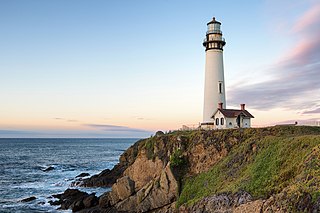
Pigeon Point Light Station or Pigeon Point Lighthouse is a lighthouse built in 1871 to guide ships on the Pacific coast of California. It is the tallest lighthouse on the West Coast of the United States. It is still an active Coast Guard aid to navigation. Pigeon Point Light Station is located on the coastal highway, 5 miles (8 km) south of Pescadero, California, between Santa Cruz and San Francisco. The 115-foot (35 m), white masonry tower, resembles the typical New England structure.

Rincon de los Esteros, also known as Innovation Triangle, the Golden Triangle, the Innovation District, or simply as Rincon, is a vast district of San Jose, California, making up a significant portion of North San Jose. The district has one of the largest concentrations of high tech company headquarters and campuses in Silicon Valley.
